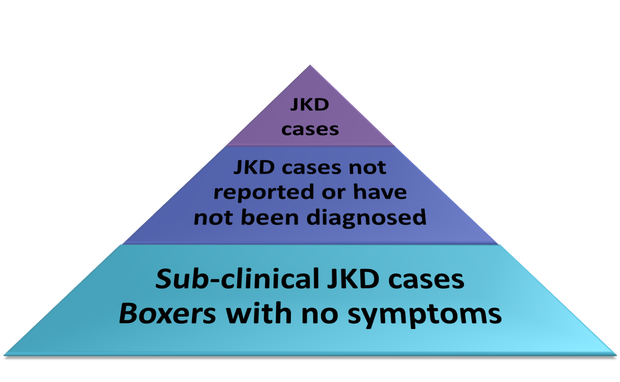Why is there a low frequency of Boxer JKD cases?
- A major factor that accounts for a shortage of affected cases is the 'redundancy' of the kidneys. We know that we can donate one of our kidneys without any ill-consequence. In fact we can also lose the equivalent of half of the second kidney to give a 75% loss of total kidney function, and still be healthy and symptom free. It is only when there is a greater loss of kidney function that symptoms of kidney failure appear. This means that many dogs with severely affected kidneys will appear absolutely normal and healthy throughout most of their lives. Nevertheless, these sub clinical cases of Boxer JKD may be more sensitive to external triggering factors.
- One external factor is urinary tract infection (UTI). Damaged and deformed kidneys are more liable to bacterial infection, which in itself can be a problem requiring antibiotic treatment. The presence of UTIs may be the first indication that there is something wrong in a puppy. It is NOT that the bacterial infections cause the kidney damage; it is the abnormality of the kidney function in Boxer JKD allowing 'reflux' that leads to the infection. Bitches are more prone to UTIs than dogs because of their different urinary tract anatomy. Boxer JKD is more readily detected in bitches compared to dogs. Pregnancy may also be a factor that triggers the onset and the detection of Boxer JKD in bitches. The incidence of Boxer JKD in bitches maybe tenfold compared to males. Affected Boxer JKD male dogs may be 'sub clinical' and missed completely living a normal healthy life.
- Ultrasound and post-mortem studies indicate a variable degree of damage to the kidneys in confirmed Boxer JKD cases. This can explain the variation in the age of onset of the disease symptoms in different individuals. The occurrence of kidney failure in older Boxers (+3 years) could actually be due to Boxer JKD. Dogs with unilateral kidney disease (where only one kidney is developmentally abnormal) may or may not ever show signs of kidney disease or failure, depending upon the functional health of the other kidney.
- Lower protein diets may also disguise developing Boxer JKD symptoms just as they improve the welfare of affected dogs to allow them a longer and better quality of life. Ignoring animals with late onset kidney disease may be the major cause of the apparent shortage of Boxer JKD cases.
- Kidney failure is not uncommon in older dogs, if the kidneys are already compromised, then it should be expected that an earlier onset of age-related kidney failure could occur. While JKD is typically diagnosed in animals under 3 years old, later-occurring cases may erroneously be attributed to other causes. We have identified late onset kidney disease in the Boxer JKD family groups. Many ‘hidden’ JKD cases will remain normal throughout the whole of their lives.
- JKD may also be missed at another level: the cell types that typify JKD-affected kidneys can be described as pre-cancerous. Therefore, it should not be surprising that Boxers with kidney cancer have been found and this may be a further expression of the JKD. We have had cases of kidney cancer in dogs from the JKD families.
- At the other end of the age-scale, in humans it is known that kidney failure in the fetus can cause death before birth and in experimental animals it is known that kidney failure can cause early post-natal death. It is therefore possible that we may be missing Boxer JKD cases with a very early onset – they would be noted only as dead at birth or seen as early ‘fading puppies’. How often are such very early deaths investigated? We have in fact two incidences of fading puppies that on post-mortem were found to have missing or very small kidneys, and in one case siblings developed Boxer JKD later in life.



